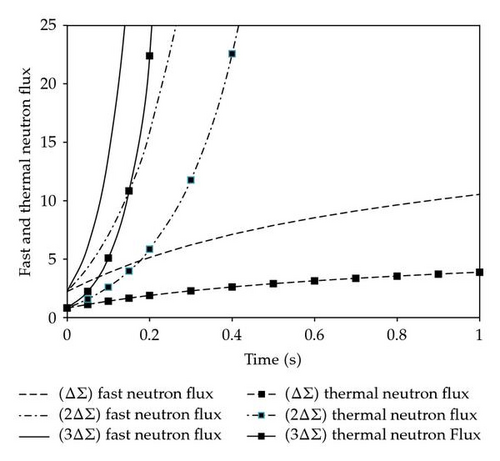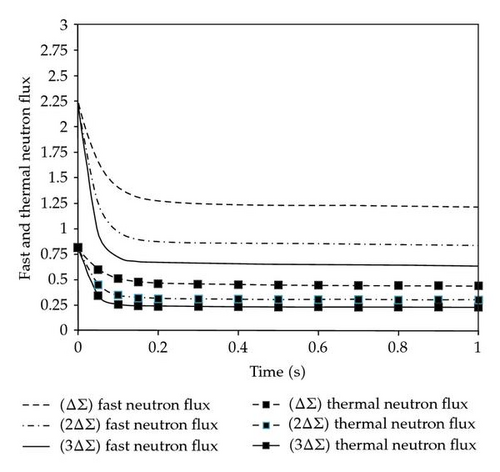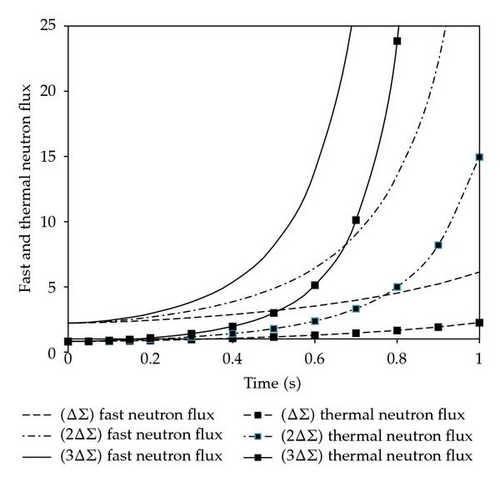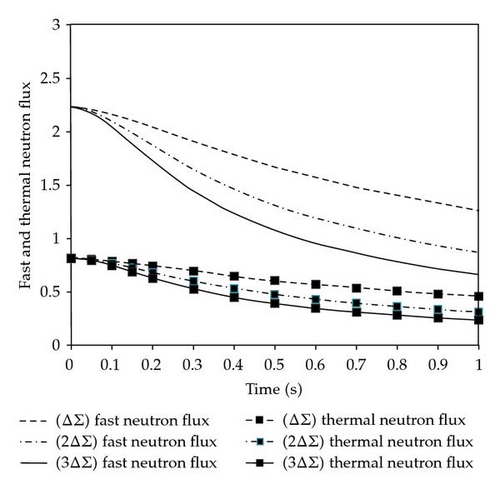Generalization of the Analytical Exponential Model for Homogeneous Reactor Kinetics Equations
Abstract
Mathematical form for two energy groups of three-dimensional homogeneous reactor kinetics equations and average one group of the precursor concentration of delayed neutrons is presented. This mathematical form is called “two energy groups of the point kinetics equations.” We rewrite two energy groups of the point kinetics equations in the matrix form. Generalization of the analytical exponential model (GAEM) is developed for solving two energy groups of the point kinetics equations. The GAEM is based on the eigenvalues and the corresponding eigenvectors of the coefficient matrix. The eigenvalues of the coefficient matrix are calculated numerically using visual FORTRAN code, based on Laguerre’s method, to calculate the roots of an algebraic equation with real coefficients. The eigenvectors of the coefficient matrix are calculated analytically. The results of the GAEM are compared with the traditional methods. These comparisons substantiate the accuracy of the results of the GAEM. In addition, the GAEM is faster than the traditional methods.
1. Introduction
In real nuclear reactor problems that involve safety considerations, the coefficients of the space-time neutron diffusion equations depend upon the neutron flux density, precursor concentration of delayed neutrons groups, space, time, and temperature feedback. The numerical methods and the analytical approximations for solving the space-time neutron diffusion equations in the nuclear reactor have been of interest in nuclear physics and reactor design.
Three-dimensional nodal mixed dual method was used for the nuclear reactor kinetics equations with improved quasistatic model and the semiimplicit scheme to solve the precursor equations [1]. A rigorous weight function in the quasistatic method was presented to solve the time-dependent multigroup diffusion equations for subcritical systems with external sources [2]. Parallelised Krylov methods were applied to the improved quasistatic approach in addition to the direct, implicit time difference, approach for solving space-time dependent multigroup neutron diffusion equations [3]. The nodal diffusion method was presented to solve space-time neutron kinetics using the finite element, primal and mixed hybrid nodal methods [4]. A one-step implicit method and a nodal modal method were studied for the solution of the time-dependent neutron diffusion equations which-based on a hexagonal spatial mesh [5–7]. An adiabatic kinetics model was developed for a boiling water reactor (BWR) core simulator AETNA [8]. Mathematical modeling of the space-time kinetics phenomena in advanced heavy water reactor, a 920 MW thermal, vertical pressure tube type thorium-based nuclear reactor, was presented using nodal modal method [9]. Class of Padé and cut-product approximations were applied to solve the two energy groups space-time nuclear reactor kinetics equations in two dimensions [10]. Adaptive Matrix Formation (AMF) method was presented and applied to homogeneous, symmetric heterogeneous, and nonsymmetric heterogeneous reactors in the cases of two and three dimensions [11]. The generalized Runge-Kutta method was developed for solving the multigroup, multidimensional, static, and transient neutron diffusion kinetics equations [12]. Computation accuracy and efficiency of a power series analytic method were presented for the time-space-dependent neutron diffusion equations with adiabatic heat up and doppler feedback [13]. The multigroup integro-differential equations of the neutron diffusion kinetics were presented and solved numerically in multislab geometry with the use of the progressive polynomial approximation [14].
The different kinds of Padé approximations were applied to the nonlinear point kinetics equations including temperature feedback via analytical inversion method [15, 16]. The straightforward recurrence relation of a power series was presented to solve the point kinetics equations in the presence of delayed neutrons with Newtonian feedback [17]. The stability of generalized Runge-Kutta method of order four was studied for the stiff system point kinetics equations with temperature feedback reactivity [18, 19]. The analytical exponential model was generalized to solve the point kinetics equations of beryllium and heavy water moderated reactors with step, ramp, and temperature feedback reactivities [20]. Power series solution (PWS) was applied for solving the point kinetics equations with lumped model temperature feedback [21]. Recently, new analytical solution, based on the roots of inhour equation, the eigenvalues of the coefficient matrix, was presented and applied for the point kinetics equations with the constant, ramp, and temperature feedback reactivities [22].
In this work, the two energy groups of the point kinetics equations and the average one group of delayed neutron are introduced. The generalization of the analytical exponential model is calculated using the eigenvalues and the eigenvectors of the coefficient matrix. The eigenvalues and the corresponding eigenvectors of the coefficient matrix are calculated. The results of the generalization of the analytical exponential model are compared with the results of the traditional methods.
2. Mathematical Model
3. Generalization of the Analytical Exponential Model
Equations (3.5) and (3.6) represent the solutions of the two energy groups of point kinetics equation with average one group of delayed neutrons. These solutions represent a generalization of the analytical exponential model for step and variable coefficient matrix A, respectively.
3.1. Eigenvalues of the Matrix A
3.2. Eigenvectors of the Matrix A
3.3. Eigenvectors of the Matrix AT
4. Results and Discussions
To check the accuracy of the results of the mathematical model of two energy groups of the homogeneous reactor kinetics equations, it is applied to the three-dimensional homogeneous reactor. This reactor is a bare homogeneous cube of side length 200 cm on each side with two neutron groups and one precursor group. The parameters of the three-dimensional homogeneous reactor are taken from [11] and shown in Table 1. The mathematical model of two energy groups of the point kinetics equations are solved by the generalization of the analytical exponential model (GAEM). Two different types of problems; step and ramp reactivities, are applied.
| Parameter | Group 1 | Group 2 |
|---|---|---|
| Diffusion coefficient D (cm) | 1.35 | 1.08 |
| Absorption cross-section Σa (cm−1) | 0.001382 | 0.0054869 |
| Neutron fission ν (neutron) | 2.41 | 2.41 |
| Fission cross-section Σf (cm−1) | 0.000242 | 0.00408 |
| Scattering cross-section | 0.0023 | 0.0 |
| Velocity v (cm/s) | 3.0 × 107 | 2.2 × 105 |
| Decay constant λ (s−1) | 0.08 | |
| Fraction of delayed neutron β | 0.0064 | |
| Keff | 0.8952858 | |
4.1. Step Reactivity
The thermal neutron flux at the center point of the two energy groups of the homogeneous reactor kinetics equations with a positive step reactivity, , is calculated in Table 2. The results of the GAEM for the two energy groups of the point kinetics equations have an accuracy comparable with the results of the adaptive matrix formation (AMF) [11], 3DKIN [30] and the exact solution for the space-time nuclear reactor kinetics equations.
| Time (s) | 3DKIN | AMF | GAEM | Exact | |
|---|---|---|---|---|---|
| h = 0.001 | h = 0.0001 | h = 0.001 | h = 0.0001 | ||
| 0.0 | 0.816 | 0.816356 | 0.816356 | 0.816356 | 0.816 |
| 0.05 | 1.124 | 1.127264 | 1.127320 | 1.127300 | 1.127 |
| 0.10 | 1.406 | 1.407563 | 1.407587 | 1.407538 | 1.407 |
| 0.15 | 1.660 | 1.660798 | 1.660782 | 1.660695 | 1.660 |
| 0.20 | 1.890 | 1.890179 | 1.890112 | 1.889979 | 1.890 |
| 0.30 | 2.289 | 2.288396 | 2.288189 | 2.287949 | 2.288 |
| 0.40 | 2.622 | 2.621201 | 2.620796 | 2.620432 | 2.620 |
The fast and thermal neutron flux of the two energy groups of the point kinetics equations with a negative step reactivity, , is calculated in Table 3. This table substantiates the accuracy of the results of the GAEM compared with the results of the AMF [11].
| Time (s) | AMF | GAEM | ||
|---|---|---|---|---|
| Fast | Thermal | Fast | Thermal | |
| 0.0 | 2.228929 | 0.816356 | 2.228929 | 0.816356 |
| 0.05 | 1.645481 | 0.601048 | 1.645513 | 0.601060 |
| 0.10 | 1.409437 | 0.513969 | 1.409514 | 0.513998 |
| 0.15 | 1.313217 | 0.478479 | 1.313283 | 0.478504 |
| 0.20 | 1.273214 | 0.463731 | 1.273261 | 0.463748 |
| 0.30 | 1.247508 | 0.454268 | 1.247519 | 0.454272 |
| 0.40 | 1.239679 | 0.451400 | 1.239661 | 0.451394 |
Figure 1. shows the fast and thermal neutron flux at three values for positive step reactivities, and −3(0.0000369). And, the fast and thermal neutron flux at three types of negative step reactivities, and +3(0.0000369), are shown in Figure 2.


The calculation times, CPU times, of the GAEM to the AMF method are 0.43 s: 0.79 s at the same time step using personal desktop computer (processor: Core 2 Duo, 2.93 GHz). This means that the GAEM for two energy groups of the point kinetics equations is faster than the AMF for the space-time nuclear reactor kinetics equations.
4.2. Ramp Reactivity
To substantiate the accuracy and the efficiency of the generalization of the analytical exponential model for solving two energy groups of the point kinetics equations with linear ramp reactivity, it is applied to three dimensional homogeneous reactor. The fast and thermal neutron flux for a positive ramp reactivity, , are calculated in Table 4. This table is demonstrates the comparison between the results of the GAEM and AMF.
| Time (s) | AMF | GAEM | ||
|---|---|---|---|---|
| Fast | Thermal | Fast | Thermal | |
| 0.0 | 2.228929 | 0.816356 | 2.228929 | 0.816356 |
| 0.05 | 2.276718 | 0.833995 | 2.276712 | 0.833993 |
| 0.10 | 2.399085 | 0.879151 | 2.399048 | 0.879137 |
| 0.15 | 2.580062 | 0.945931 | 2.579972 | 0.945898 |
| 0.20 | 2.816616 | 1.033217 | 2.816456 | 1.033158 |
| 0.30 | 3.484146 | 1.279522 | 3.483773 | 1.279385 |
| 0.40 | 4.529838 | 1.665354 | 4.529085 | 1.665078 |
The fast and thermal neutron flux of the two energy groups of the point kinetics equations with a negative ramp reactivity, , is calculated in Table 5.
| Time (s) | AMF | GAEM | ||
|---|---|---|---|---|
| Fast | Thermal | Fast | Thermal | |
| 0.0 | 2.228929 | 0.816356 | 2.228929 | 0.816356 |
| 0.05 | 2.182204 | 0.799109 | 2.182170 | 0.799097 |
| 0.10 | 2.072954 | 0.758795 | 2.072892 | 0.758773 |
| 0.15 | 1.936615 | 0.708488 | 1.936528 | 0.708456 |
| 0.20 | 1.795565 | 0.656446 | 1.795460 | 0.656407 |
| 0.30 | 1.541171 | 0.562589 | 1.541033 | 0.562539 |
| 0.40 | 1.340555 | 0.488582 | 1.340396 | 0.488524 |
The fast and thermal neutron flux at different types of positive ramp reactivities, and −3(0.0000369 t), is shown in Figure 3. And also, the fast and thermal neutron flux at different types of negative ramp reactivities, and +3(0.0000369 t), are shown in Figure 4.


For ramp reactivity, The calculation times, CPU times, of the GAEM to the AMF method are 0.45 s: 0.81 s. This means, the GAEM is faster than the AMF.
5. Conclusions
Two energy groups of the point kinetics equations are represented a mathematical form for three dimensional homogeneous reactor kinetics equations and average one group of precursor delayed neutrons. The mathematical form was rewritten in the matrix form. Generalization of the analytical exponential model (GAEM) was developed to solve the new mathematical matrix form for three dimensional homogeneous reactor. This GAEM based on the eigenvalues and the corresponding eigenvectors of the coefficient matrix.
The results of GAEM were compared with the AMF, 3DKIN, and the exact solution for three dimensional homogeneous reactor. This comparison substantiated the accuracy of the results of the GAEM for different types of reactivities. In addition, the GAEM for the mathematical form, two energy groups of the point kinetics equations, is faster than any other traditional methods. So, this mathematical form may be one of the most important models for the neutron diffusion equations in the nuclear reactors.




